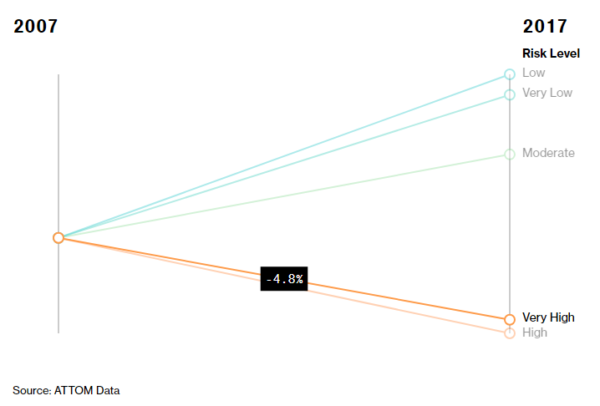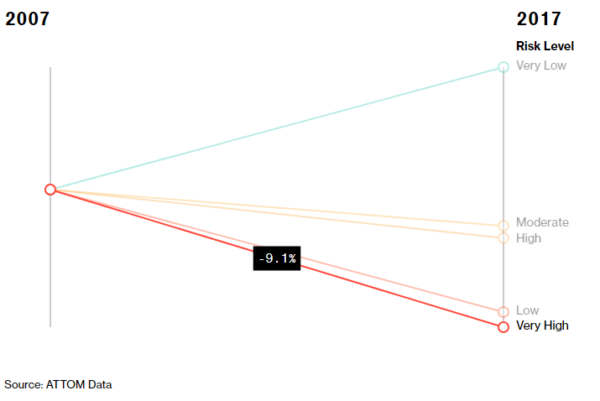Climate Change May Already Be Hitting the Housing Market
By Christopher Flavelle and Allison McCartney June 18, 2018, Updated February 18, 2020
Even as President Donald Trump downplays the importance of climate change, there are signs that Americans may be taking it more seriously—at least when it comes to buying a house.
Between 2007 and 2017, average home prices in areas facing the lowest risk of flooding, hurricanes and wildfires have far outpaced those with the greatest risk, according to figures compiled for Bloomberg News by Attom Data Solutions, a curator of national property data. Homes in areas most exposed to flood and hurricane risk were worth less last year, on average, than a decade earlier.
AVERAGE HOME PRICE APPRECIATION BY FLOOD RISK

Attom Data looked at the annual change in home prices and sales across 3,397 cities around the country, then divided those cities into five groups based on their exposure to various types of natural disasters. What they found suggests the threats of climate change are beginning to register.
On average, home prices across the cities analyzed by Attom Data increased 7.3 percent between 2007 and 2017. That figure masks deep drops in vulnerable areas.
“Natural disaster risk is certainly not the only factor consumers are considering when buying a home,” said Daren Blomquist, Attom Data’s senior vice president for communications. But he said the figures provide “some evidence real estate consumers are responding to natural disaster risk, albeit somewhat erratically.”
AVERAGE HOME PRICE APPRECIATION BY HURRICANE SURGE RISK

The data suggest the relationship between climate risk and home prices isn’t always a straight line. That’s because home buyers have to weigh the risk of disasters against the so-called amenity value of living near water or at the edge of the forest, according to Carolyn Kousky, director for policy research for the Risk Management and Decision Processes Center at the Wharton School.
“It’s probably very likely that people are starting to have a greater awareness of disaster risk,” Kousky said. “The tricky part is that some of the riskiest areas are also such high amenities.”
For example, home values in Key Biscayne, Florida were 19 percent higher in 2017 than in 2007, despite the island’s flood risk. Homes in Aromas, California, which Attom Data classifies as a very high wildfire risk, increased 43 percent over the same period. Both areas offer natural beauty that buyers have apparently concluded is worth the danger.
